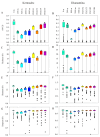The Vertical Metabolic Activity and Community Structure of Prokaryotes along Different Water Depths in the Kermadec and Diamantina Trenches
- PMID: 38674652
- PMCID: PMC11052081
- DOI: 10.3390/microorganisms12040708
The Vertical Metabolic Activity and Community Structure of Prokaryotes along Different Water Depths in the Kermadec and Diamantina Trenches
Abstract
Prokaryotes play a key role in particulate organic matter's decomposition and remineralization processes in the vertical scale of seawater, and prokaryotes contribute to more than 70% of the estimated remineralization. However, little is known about the microbial community and metabolic activity of the vertical distribution in the trenches. The composition and distribution of prokaryotes in the water columns and benthic boundary layers of the Kermadec Trench and the Diamantina Trench were investigated using high-throughput sequencing and quantitative PCR, together with the Biolog EcoplateTM microplates culture to analyze the microbial metabolic activity. Microbial communities in both trenches were dominated by Nitrososphaera and Halobacteria in archaea, and by Alphaproteobacteria and Gammaproteobacteria in bacteria, and the microbial community structure was significantly different between the water column and the benthic boundary layer. At the surface water, amino acids and polymers were used preferentially; at the benthic boundary layers, amino acids and amines were used preferentially. Cooperative relationships among different microbial groups and their carbon utilization capabilities could help to make better use of various carbon sources along the water depths, reflected by the predominantly positive relationships based on the co-occurrence network analysis. In addition, the distinct microbial metabolic activity detected at 800 m, which was the lower boundary of the twilight zone, had the lowest salinity and might have had higher proportions of refractory carbon sources than the shallower water depths and benthic boundary layers. This study reflected the initial preference of the carbon source by the natural microbes in the vertical scale of different trenches and should be complemented with stable isotopic tracing experiments in future studies to enhance the understanding of the complex carbon utilization pathways along the vertical scale by prokaryotes among different trenches.
Keywords: Diamantina Trench; Kermadec Trench; benthic boundary layer; microbial metabolic activity; water column.
Conflict of interest statement
The authors declare no conflicts of interest.
Figures







Similar articles
-
Metagenome sequencing and 982 microbial genomes from Kermadec and Diamantina Trenches sediments.Sci Data. 2024 Oct 1;11(1):1067. doi: 10.1038/s41597-024-03902-z. Sci Data. 2024. PMID: 39354003 Free PMC article.
-
Metabolic activity and community structure of prokaryotes associated with particles in the twilight zone of the South China Sea.Front Microbiol. 2022 Dec 6;13:1056860. doi: 10.3389/fmicb.2022.1056860. eCollection 2022. Front Microbiol. 2022. PMID: 36560947 Free PMC article.
-
Geographical distribution and driving force of microbial communities in the sediments of Diamantina and Kermadec trenches.Front Microbiol. 2024 Nov 18;15:1474645. doi: 10.3389/fmicb.2024.1474645. eCollection 2024. Front Microbiol. 2024. PMID: 39624723 Free PMC article.
-
Vertically distinct microbial communities in the Mariana and Kermadec trenches.PLoS One. 2018 Apr 5;13(4):e0195102. doi: 10.1371/journal.pone.0195102. eCollection 2018. PLoS One. 2018. PMID: 29621268 Free PMC article.
-
Illuminating Key Microbial Players and Metabolic Processes Involved in the Remineralization of Particulate Organic Carbon in the Ocean's Twilight Zone by Metaproteomics.Appl Environ Microbiol. 2021 Sep 28;87(20):e0098621. doi: 10.1128/AEM.00986-21. Epub 2021 Jul 28. Appl Environ Microbiol. 2021. PMID: 34319792 Free PMC article.
Cited by
-
Metagenome sequencing and 982 microbial genomes from Kermadec and Diamantina Trenches sediments.Sci Data. 2024 Oct 1;11(1):1067. doi: 10.1038/s41597-024-03902-z. Sci Data. 2024. PMID: 39354003 Free PMC article.
References
-
- Steinberg D.K., Van Mooy B.A.S., Buesseler K.O., Boyd P.W., Kobari T., Karl D.M. Bacterial vs. zooplankton control of sinking particle flux in the ocean’s twilight zone. Limnol. Oceanogr. 2008;53:1327–1338. doi: 10.4319/lo.2008.53.4.1327. - DOI
Grants and funding
LinkOut - more resources
Full Text Sources

